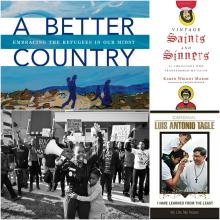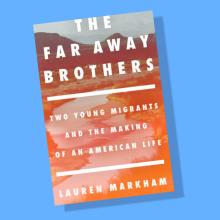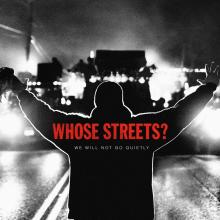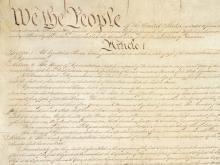Arts & Culture

mother!'s grotesquely literal take on the Eucharist also fundamentally misses what communion means.

What is Star Wars? For the first decade or so after George Lucas made what would come to be known as Episode IV, which celebrates its 40th anniversary this year, the answer to that question was easy: Star Wars was whatever Lucas said it was.

LOGAN LUCKY, the new film from Steven Soderbergh, is a delicious surprise. It’s about working-class Southerners robbing the Charlotte Motor Speedway during a NASCAR race, and its weaving of the intricacies of planning, executing, and living in the post-heist glow is hilarious and even warm.
More than that, it’s a heist film in which ordinary people (not slick, hypermasculine Armani warriors) employ imagination instead of heavy artillery to take money from an institution that doesn’t need it anyway. The fact that the target of the theft got the money through selling overpriced, undernourishing food and drink is only one piece of bonus philosophical content. It’s a rare thing: a thoroughly entertaining movie with real things to say about the moment it is released. At a time when left-right political division in the U.S. has intensified, Soderbergh, a Southerner who works from New York, has made a red-blue reconciliation comedy.

Our Streets
Filmmakers Sabaah Folayan and Damon Davis use their backgrounds as activists and artists to create Whose Streets?, a gripping documentary about the Ferguson uprising. Through scenes of hope and resistance, Whose Streets? reclaims Mike Brown’s story and shows Ferguson through the eyes of those who experienced it. whosestreetsfilm.com

A way of binding books that will prevent
breaking of backs.

Who can forget Harold Camping, the Christian radio media mogul who picked two dates in 2011, hit the airwaves, put up billboards, solicited money — and nada. He joined some rather famous names — Edgar Cayce, Sun Myung Moon, Jerry Falwell, and Pat Robertson [at least twice, but before he had access to the White House], and John Hagee among them — of failed futurists. Heck, Sir Isaac Newton himself, great astronomer and mathematician, bet that Jesus would return in the year 2000.

DuPage County Judge Joseph Bugos signed arrest warrants and set $50,000 bonds against the players — James Cooksey, Kyler Kregel, Benjamin Pettway, Noah Spielman and Samuel TeBos — late Monday afternoon. Prosecutors charged the athletes with aggravated battery, mob action, and unlawful restraint.

Faith communities can play a powerful role in preventing violence and supporting survivors, but collectively we’re falling short. Two-thirds (65 percent) of pastors say they speak once a year or less about sexual and domestic violence, with 1 in 10 never addressing it at all. This failure has a deep and lasting impact.

APOCALYPSE IS in the air. Perhaps it was the eclipse in August, or the always accelerating churn of foreign and domestic scandal in the news, or the looming threat of climate change. Or perhaps people have always lived this way. But the world feels weighty and close to falling apart, and we start wondering how we would handle the aftermath.
When the English Fall, by David Williams (no relation), examines that possibility: a post-apocalyptic novel about a catastrophe that makes the low-tech, community-minded lifestyle of the Amish the only viable one. We witness the immediate aftermath of the modern life of the English (the Amish name for all non-Amish people) failing due to a solar storm; society is placed under immense stress without the ability to feed itself. In a fantastic choice, this is examined through the life of an Amish farmer named Jacob—how he adapts and the difficult decisions that he must make for his way of life to survive.

WITHIN THE FIRST pages of The Far Away Brothers: Two Young Migrants and the Making of an American Life , it becomes clear that Lauren Markham understands the complexities of immigration to the United States and has personally worked with immigrants stuck in its tangled web. In a journalistic style, she reports the story of teenage twin brothers Raúl and Ernesto, fleeing gang violence in El Salvador, hoping to find safety and new opportunities in El Norte.
Markham has worked in refugee resettlement and immigrant education for the past decade. In this book she covers all aspects of immigration in well-researched detail. But she also seems to understand that while any reader could argue immigration policy, no one can argue with the Flores brothers’ story, from the crippling poverty in rural El Salvador, where life is cheap and disposable, to the stark loneliness of their lives in the U.S., far from the comforts of family and home.

WALTRINA MIDDLETON'S VOICE lifts you to the highest highs with bellows of crisp spoken word. Seamlessly, her croons can plunge you down the rhythm of any blues-laced freedom song. Your heart is gripped with deep, rolling riffs of truth spoken.
Harnessing the power of pain is just one of her many spiritual gifts. Middleton is an ordained minister, activist, and artist with roots in the Gullah Geechee community in South Carolina. A self-professed country girl, she grew up in Hollywood, S.C., on the coastal Gullah Sea Island of Yonges, about 30 minutes outside of Charleston.
“It was beautiful—a swampland with dirt roads, farm, and fields,” she told Sojourners. “I made my grandparents’ hogs my pets before I realized they were actually dinner.”
It’s been a winding road on the path to self-discovery for Middleton, but she says music was there from the very beginning. “Music was central to our family,” she said. “It was an intergenerational medium that brought us together, but also rooted us in our faith.”
Her grandparents had 16 children, and all of them could sing or play an instrument. The family put together a group called the Middleton Gospel Singers that toured the local church community. “Part of the country circuit is to have some kind of gospel group,” she said. “The women in my family were the instrumentalists. I was always with my family when we would be in church all day going to these programs. The whole point was to worship God. It was just something that you did.”
Even when there wasn’t a church function or performance, Middleton says music was a part of her everyday life. “We had this big ol’ barn, and we would be in the barn sitting, rehearsing, and practicing,” she said. “Sometimes there would be a fire; sometimes people would just come, listen, and talk. While they were rehearsing, we would sit out there and eat crab.”
At these family gatherings, her artistic flair began to take shape. She admired her older cousins and says they heavily influenced her style. “They had this depth to them that I couldn’t describe,” she said. “It was very low and lamenting. I found myself trying to imitate their style. It also taught me that worship could also be lamenting.”

As filmmaking, Whose Streets is dramatic and powerful. As a historical document, it holds even more weight.

More than half of Americans surveyed — 53 percent — believe undocumented persons have no constitutional rights when, in actuality, they do.

Please, America! Do not revert back from unbelievable acts of love shown throughout Hurricane Harvey-ravaged Houston, to the hate-filled spirit of violence in Charlottesville.

When asked about the tweet, Sanders replied, “I think that’s one of the more outrageous comments that anyone could make, and certainly something that I think is a fireable offense by ESPN.” There’s a revealing irony in this statement. I’m sure that Donald Trump and Sarah Huckabee Sanders do not think they are involved in white supremacy. I’m sure that they are not card-carrying members of any white supremacist group. But I’m also sure that they are unconsciously guided by white supremacy.
1. Americans Have Given Up on Public School. That’s a Mistake.
“Unfortunately, the current debate’s focus on individual rights and choices has distracted many politicians and policy makers from a key stakeholder: our nation as a whole. As a result, a cynicism has taken root that suggests there is no hope for public education. This is demonstrably false. It’s also dangerous.”

“Then They Came For Me” marks the 75th anniversary of President Franklin Roosevelt’s signing of Executive Order 9066, which authorized the internment of all people on the West Coast thought to be a threat to national security.

Since the beginning of the year
I've had a fear of flying.
So much white anger in the air.
I can't breathe.

This present social climate presents a kairos moment for businesses pursuing social justice. In a recent New York Times interview, Apple CEO Tim Cook pointed out, “I think [business leaders] have a moral responsibility to help grow the economy, to help grow jobs, to contribute to this country and to contribute to the other countries that we do business in.” I wholeheartedly agree.

As I attempt to navigate my new normal after the traumatizing experience of standing up for love against white supremacy in Charlottesville, I am certain that empathy alone is not enough. True empathy, particularly in relation to social justice, must be followed by action. Otherwise, the cycle of marginalization, oppression, discrimination, and pain will continue.